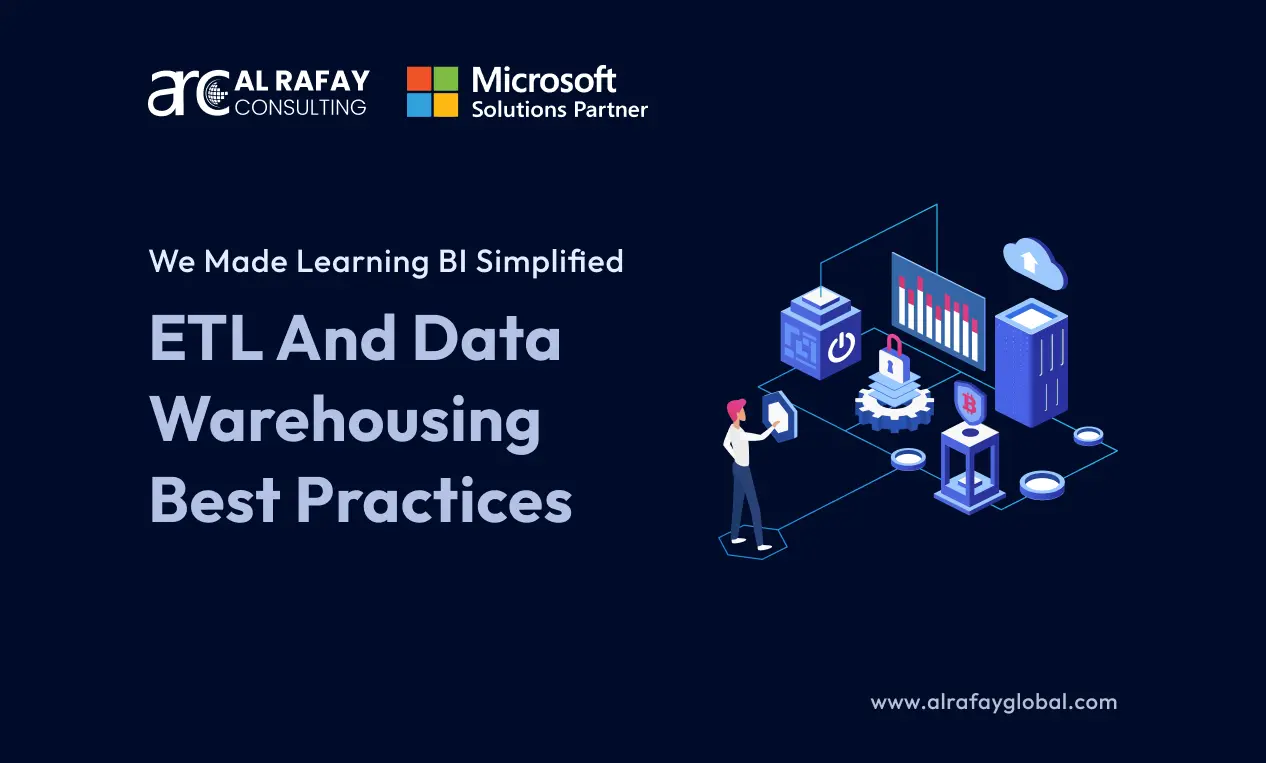We are living in the information age and today all companies, regardless of their industry sector are producing huge amounts of data. This data is crucial for these companies to drive their business growth and make intelligent decisions. Data is the lifeblood of any modern organization. It enables decision-making, insights, and innovation. However, data alone is not enough. It needs to be processed, organized, and stored in a way that makes it accessible and secure. This is where cutting-edge ETL and data warehousing technologies come in.
ETL and Data Warehousing are two essential components of any data-driven enterprise. They enable the collection, integration, and analysis of data from various sources and in different formats. But working with this data is not always easy and a lot of challenges might arise in the ETL and data warehousing process if not properly planned. Therefore, it is crucial to follow best practices to ensure optimal results and avoid common pitfalls.
In this blog, we will start by building fundamental knowledge of both ETL and Data warehousing and discuss some of the best practices that can help you achieve efficient and effective data management. So, let’s start right away.
Understanding ETL and Data Warehousing
Before we dive into the best practices, let us first understand what ETL and Data Warehousing are, and why they are important.
Basics of ETL
The word ETL stands for Extract, Transform, and Load. In very simple terms, it is a process of extracting data from various data sources, transforming it according to predefined rules and logic, and loading it into a target destination. The target destination can be a database, a data warehouse, a data lake, or any other data storage system.
The ETL process is very important for large organizations that produce huge amounts of data and store it in multiple locations. For example, data from different departments like HR, production, maintenance, and CRM can be stored in different locations. The purpose of ETL is to integrate data from disparate and heterogeneous sources and make it consistent, clean, and ready for analysis. The ETL also includes processing data by performing a lot of cleaning operations on it, such as filtering, aggregating, joining, splitting, and much more.
Most of the time and in most traditional industries the ETL process is performed in batches or in simple terms it is performed at regular intervals like every week or month. However, a lot of applications now require the integration of real-time data for their operations, which has also transformed the ETL process in which data is processed as soon as it arrives.
Data Warehousing Fundamentals
When the data from multiple sources is processed it needs to be stored in a centralized place. This is what a data warehouse is all about. A data warehouse is a centralized repository of integrated and structured data that supports analytical and reporting applications. A data warehouse stores historical and current data from various sources, and organizes it into a logical and consistent model that facilitates easy and fast querying and analysis.
You might think that a data warehouse is just some big spreadsheet that contains thousands of rows and columns. While this is partially true, it is far from the complete picture. A data warehouse typically follows a dimensional modeling approach, in which the data is divided into facts and dimensions. The Facts in the warehouse are basically numerical measures that represent business events or transactions, such as sales, orders, or revenue. Dimensions are descriptive attributes that provide context and meaning to the facts, such as date, time, product, customer, or location.
If that is not complex enough here are some more details about the data warehouse that might shock you. A data warehouse can also have multiple layers or schemas, such as staging, operational data store (ODS), data mart, or star schema. Each of the layers is different from each other and is used for different purposes. For example, one layer might be used for data cleaning while the other may be used for data consolidation or segmentation.
In short, the main purpose of a data warehouse is to provide a single source of truth for data analysis and reporting and to enable business intelligence (BI) and data mining.
ETL And Data Warehousing: Interdependency
ETL and Data Warehousing are closely related and interdependent. ETL is the process that feeds data into the data warehouse, and data warehousing is the outcome of the ETL process. Without ETL, there would be no data warehouse, and without a data warehouse, there would be no need for ETL. Together, they form a powerful and robust data management system that can support various business needs and objectives.
ETL Processes And Their Best Practices
As I stated above, the ETL is a complex process and it requires careful planning, designing, and development. The process consists of a lot of steps and components, and each of these steps is essential for a successful project. To ensure a successful and efficient ETL process, it is important to follow some of the best practices that have been proven and tested by experts and practitioners. Here are some of the ETL best practices that you should consider and implement in your ETL projects for each of the steps.
Data Extraction
The extraction is the first and probably the most important step because, without it, none of the other steps can be performed, and if there is an error in this step then it puts the whole process at risk. It involves connecting to the source systems, selecting the relevant data, and extracting it for further processing. There are a lot of methods of performing this step depending on the type of work and data sources. For instance, it can be done using APIs, web services, SQL queries, files, or scripts. The data extraction method depends on the type, format, and availability of the source data, as well as the frequency and volume of the extraction.
- Source system considerations: Before extracting data from a source system, you should first carefully understand its structure, schema, metadata, and constraints. This consideration should also include the impact that the extraction process might make on the source such as such as the load, performance, and availability. In addition to this, it is also very important that you avoid extracting data during peak hours or periods of high activity, and use methods that minimize the disruption and overhead on the source system such as change data capture (CDC), or snapshot isolation
- Use incremental extraction: Incremental extraction is a technique that extracts only the new or changed data from the source system, instead of extracting the entire data set every time. This is very helpful in enhancing efficiency as you can imagine extracting only the new data reduces the amount of data that needs to be transferred, transformed, and loaded. However, incremental extraction requires more logic and coordination between the source and the target systems, and may not be feasible or applicable for some types of data or sources.
- Perform data profiling and cleansing at the source: As you might have guessed from the name, profiling is basically the process of understanding the characteristics of the data and it is a very important step before cleaning. Data profiling and cleansing are essential steps to ensure the accuracy, completeness, and consistency of the data. However, instead of performing these steps after the data extraction, it is better to perform them at the source, if possible. Doing this, not only reduces the amount of data to be transferred but also prevents the propagation of errors and anomalies to the target system.
Data Transformation
According to most data engineers, the transformation is the second most difficult process of the entire ETL cycle. It involves applying various rules and logic to the extracted data to transform it into the desired format and structure for the target system. To understand it simply, you can say that it is a more advanced form of data cleaning. The transformation can be done using a lot of methods like using ETL tools, scripts, functions, or procedures. Let’s take a look at some of the ETL best practices for this important step.
- Ensure data quality: It is extremely important to ensure data quality during the data transformation step, by applying various checks, validations, and corrections to the data. Data engineers measure the quality of data on the basis of various benchmarks like accuracy, completeness, consistency, timeliness, etc. The quality of data can be ensured by the engineers using various techniques, such as data cleansing, data standardization, data validation, data deduplication, data enrichment, and data auditing.
- Use transformation logic and rules: Probably one of the most important points in transformation is the use of logic and rules. This is because it is crucial to transform data based on it’s specific business rules. For example, accounting data cannot be transformed based on the logic and rules used in the engineering data. Transformation logic and business rules are essential to ensure the consistency, integrity, and relevance of the data. However, they should be documented, tested, and maintained properly, and updated whenever there are changes in the source the target systems, or the business requirements.
- Parallel processing for efficient transformations: Parallel processing is a technique that divides the data and the transformation tasks into smaller and independent units, and executes them simultaneously on multiple processors or threads. This greatly enhances the efficiency and speed of the ETL process by reducing the execution time and the resource consumption, but requires more coordination and synchronization between the units, and may not be suitable or feasible for some types of data or transformations.
Data Loading
Simply put, loading is the process of transferring the data from the temporary storage to a more permanent storage area which can be a data warehouse, the data lake, or the database. This step fundamentally serves as a bridge between data preparation and its actual usability for analytics and reporting. There are a lot of methods for loading the data and it requires a separate blog to discuss them in detail. But here are the main methods briefly:
- Full Load: Initial loading of the entire dataset, often during initial ETL setup.
- Incremental Load: Frequent updates for new or changed data since the last load.
- Bulk Insert: Efficient mass insertion of large data volumes, often optimized for performance.
- Change Data Capture (CDC): Real-time capturing of data changes at the source for near-instant updates in the target system.
- Full Load: Initial loading of the entire dataset, often during initial ETL setup.
Let’s take a look at some of the practices that you can use in most cases for a more efficient load process.
- Use bulk loading instead of incremental loading: As evident from the name, bulk loading is a technique that loads the entire data set into the target system in one operation, instead of loading it in smaller batches or rows. Bulk loading can improve the performance and efficiency of the data-loading process, by reducing the number of transactions, connections, and network traffic. However, there are also situations in which this method is not feasible, and incremental CDC might be more useful. So, plan your process carefully.
- Error Handling And Logging: Error handling and logging are the processes of detecting, reporting, and resolving any errors or issues that occur during the data loading process. Here are some best practices for both:
Error Handling:- Utilize try-catch blocks: These blocks allow you to capture specific exceptions and react accordingly instead of crashing the entire process.
- Implement retry logic: For temporary errors like network outages, automatically retry loading a few times before raising an alert.
- Define fallback strategies: For fatal errors, have alternative paths like skipping the problematic record or moving it to a dedicated error table for later analysis.
Logging:
- Log at different levels: Use levels like info, warning, and error to categorize different events and prioritize troubleshooting.
- Capture relevant details: Include timestamps, specific error messages, data snippets involved, and process context for thorough investigation.
- Utilize try-catch blocks: These blocks allow you to capture specific exceptions and react accordingly instead of crashing the entire process.
- Error Handling And Logging: Error handling and logging are the processes of detecting, reporting, and resolving any errors or issues that occur during the data loading process. Here are some best practices for both:
Data Warehousing Processes Best Practices
Here are some of the data warehousing best practices that you should consider and implement in your data warehousing projects.
Data Modelling
Modeling is the first process in data warehousing that we are going to discuss. At the most fundamental level, the modeling defines how the data will look in the warehouse. It is the process of defining and designing the structure, schema, and relationships of the data in the data warehouse. The data modeling method depends on the type, complexity, and requirements of the data, as well as the preferences and standards of the data warehouse. Some of the data warehousing best practices that are used by the industry experts are the following:
- Dimensional modeling instead of normalized modeling: In most cases, the BI engineers advise using the dimensional modeling technique rather than the normalized. The dimensional modeling organizes the data into facts and dimensions, as I explained earlier. Dimensional modeling can improve the usability and performance of the data warehouse, by simplifying the data structure, reducing the number of joins, and enabling fast and flexible querying and analysis. Plus, it also helps data analysts in descriptive, diagnostic, predictive, and prescriptive analytics.
- Use surrogate keys for dimension tables: Surrogate keys are recommended for dimension tables, as they can improve the performance and flexibility of the data warehouse, by avoiding the issues of data duplication, data inconsistency, and data change. Surrogate keys can also enable the implementation of various features, such as slowly changing dimensions, late arriving dimensions, or conformed dimensions.
Performance Optimization
Just like any other physical warehouse, for example, Amazon or DHL, speed and performance optimization of data warehouses is extremely important. Performance optimization is important to ensure the satisfaction and productivity of the users and the business. However, it is also essential that performance optimization should be done systematically and continuously. Following are the best practices that you should use to optimize your data warehouse solutions.
- Partitioning and clustering: Partitioning and clustering are techniques that divide and organize the data into smaller and more manageable units, based on some criteria, such as the values, ranges, or categories of the data. Partitioning and clustering can improve the performance and scalability of the data warehouse, by reducing the scan time and the disk I/O and enabling parallel processing and load balancing. Some examples of partitioning and clustering are range partitioning, list partitioning, hash partitioning, round-robin partitioning, cluster tables, cluster indexes, or materialized views.
- Optimize Storage By Compression: Compression techniques are methods and tools that reduce the size and space of the data in the data warehouse, by using various algorithms, such as zip, gzip, or bzip2. However, compression techniques should be done carefully and selectively, by considering the type, size, and complexity of the data, as well as the impact on the loading and querying performance. Some examples of compression techniques are row compression, column compression, page compression, or hybrid compression.
Wrapping Up
In conclusion, the synergy between ETL and Data Warehousing, fortified by adherence to best practices, empowers organizations to make data-driven decisions with confidence. The size of the project doesn’t matter, and implementing ETL and data warehousing best practices should be uniform and standardized for all projects.
It’s crucial to recognize that the journey doesn’t end with the implementation of best practices; it’s an ongoing commitment to refining and adapting strategies as data volumes grow and technology evolves. Continuous monitoring, logging, and learning from challenges contribute to a resilient and future-proof data architecture.













